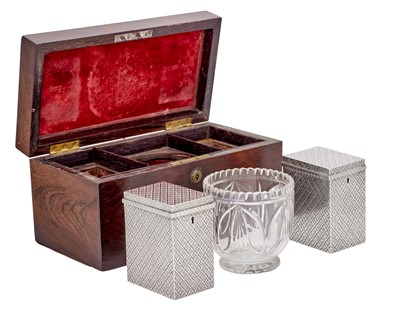13th Jan, 2024 9:30 GMT/BST
Jewellery, Watches & Silver
2190
A George II and a George III Silver Tea-Caddy, in Rosewood Caddy
The First Apparently Unmarked, Possibly 1750s, The Second by William Troby, London, 1814, The Rosewood Caddy Circa 1814
the silver tea-caddies each oblong, the sides engraved with foliage on a matted ground and within trelliswork, the hinged covers similarly engraved and with stepped bezel engraved with scrolls and cinqfoils, each with lock plate and lead-lined, in fitted oblong rosewood caddy with foliage-cast brass handle and with cut-glass bowl
the caddy 30.5cm wide, the silver tea-caddies each 11.5cm high, gross weight of silver 31oz 15dwt, 988gr (3)
These distinctive tea-caddies are very much in the style of known examples produced by Edward Wakelin in the 1750s. Examples, though with slightly more elaborate engraving, include a pair, along with a sugar-box, which are marked for London, 1758 and sold from an Important Washington D.C. collection (Christie's, New York, 7 April 2021, lot 64) and a single example, marked for 1752, which was ordered from Wakelin by Sir Edward Winnington, Bt. (Bonhams, London, 15 March 2002, lot 211). The latter example is listed in the records of Edward Wakelin, known as 'Edward Wakelin's Gentleman's Ledger' which are preserved at the Victoria and Albert Museum and provide a fascinating record of silver production in the 18th century. This form of caddy was to continue being produced into the 1760s by other silversmiths such as Pierre Gillois, for example one marked for 1768 now in the collection of the Victoria and Albert Museum (museum number M.320-1962) and a pair of gilt examples (A. Stevens, et al., The Story of British Tea Chests and Caddies, Woodbridge, 2022, p. 310, fig 17.21).
The later iterations of the form lack the stepped bezel on the hinged cover which would seem to have been a feature of the earlier Edward Wakelin examples, suggesting that the present examples are more closely related to the examples from the 1750s, rather than the later examples. The difference in the actual weight of the unmarked example compared to the engraved scratch weight, 15oz versus 13oz 7dwt respectively, is probably explained by the existence of the original lead lining inside the body. This lining is very likely that which was applied when the caddy was created. The ledger entry for the example made for Sir Edward Winnington includes a charge of £3 3s for 'making the lock, graving the mosaick [sic] and lyning [sic]', along with the charge of £6 1s for the making of the caddy itself and a further charge of 10s for making a case. While we normally associate these caddies as being made in pairs this last charge is interesting as it shows that this was not always the case. Winnington opted for a single, cased, caddy and presumably the original owner of the present example also purchased a single example. It can only be assumed that the greater use of different types of tea by the 19th century necessitated the creation, in 1814, of a matching silver caddy which was cased, along with the cut-glass mixing bowl and all contained in the present brass-bound rosewood caddy.
Sold for £1,200
Estimated at £600 - £800
One caddy is apparently unmarked. The base of this example is engraved with scratch weight '13=7'. The other caddy is marked on side with lion passant, duty mark, date letter and duty mark. Further marked inside cover with maker's mark, lion passant and date letter. The marks are generally clear. There is some overall minimal surface scratching and wear, consistent with age and use. The locks are replaced on the first example and possibly replaced on the second example. Each is lead lined, there is some loss, wear and damage to the lining. The glass bowl with some minor scratching and chips overall. The rosewood caddy with wear, chips and scratching overall. The cover and part of the back are each very sun-faded and with some staining. There is some minor bruising to the hinge on the later example.
We are happy to provide Condition Reports to Prospective Buyers, but would welcome your request as soon as possible, preferably at least 48 hours before the Day of Sale.
We cannot guarantee a reply to any requests made within 48 hours of the start of the auction. The absence of a condition report from a lot does not mean that the lot is in perfect condition.
A Condition Report is an honest expression of our opinion, not a statement of fact and is provided as a service to the Seller. All lots are available on public view ahead of an auction and we encourage people to see an item in person when possible.
Our Condition Reports are not prepared by professional conservators, restorers or engineers, and are prepared with the naked eye unless otherwise stated.
Works are not examined out of the frame, unless specifically stated. We accept no liability for the opinions expressed in any Condition Report.
Tennants Auctioneers do not cover damage to gilded wood or plaster picture frames, or to picture frame glass whilst the item is in our possession.
Auction: Jewellery, Watches & Silver, 13th Jan, 2024
Jewellery, Watches & Silver Sales bring together a wide a range of affordable period and modern jewellery, vintage and collectable watches, and silver from the 18th to 21st century.
Viewing
Wednesday 10 January - Friday 12 January 10am-4pm, and morning of sale from 8am
Sell one like this
If you've got a similar item to sell, complete the valuation form below and one of our experts will get in touch.






















